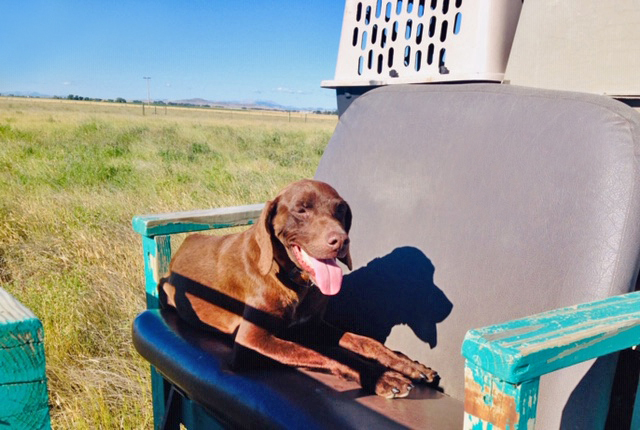Ask a professional trainer-handler of pointing dogs to name his best dog ever and you will likely get an ambiguous or evasive answer. Not so from Jim Heckert, who broke into the pro ranks long ago and has been at it ever since while also managing quail shooting plantations, including Wire Grass at Albany, Georgia for Thomas Vail of Cleveland Plain Dealer fame and currently Cedar Grove Plantation at Clarksville, Virginia for my friend Will Pannill.
Jim is a Marine combat veteran of the Vietnam War and winner of numerous AKC open pointing dog championships, all-breed and specific breed, including nationals in successive years held on Fred Leggett’s Cloverdale Farm at Danville, Virginia where Jim for several years trained, during snowy months in his native Pennsylvania. Immediately after Vietnam he worked for several years as a professional urban firefighter in a suburb of Washington DC and in Pennsylvania’s capital city, Harrisonburg.
“I attended firefighter school in both cities and as reward for finishing each first in my class got to choose my fire house. I picked the ones with the most fire calls, seeking the adrenalin rush combat had provided in Vietnam, I guess.” Jim says. He still bears physical and emotional scars from the Vietnam years, and working with bird dogs helps Jim cope with them.
The “best dog” question was put to Jim this Labor Day at Choteau, Montana where for the last twenty years Jim has trained dogs in August and September. (Choteau lies on the Rocky Mountain Front in ranching country celebrated by author Ivan Doig in novels and in his splendid memoir of his ranch-hand childhood, This House of Sky.)
Jim’s answer was swift and unambiguous, “Gunny”.
Then Jim told us the intriguing story of how Gunny, a solid liver German Shorthair pointer bitch, became a major part of his and his wife Teresa’s life.
Jim was waiting impatiently in a Choteau veterinary clinic to obtain Coggins test and Federal Health Certificates for a friend’s mount when a stranger entered carrying an empty black plastic garbage bag. He spoke to the receptionist in grim tones, “I am here to pick up my dog.”
“I am sorry, Mr. Phipps, but we have had a series of emergency calls and we have not had time to euthanize your dog yet,” the receptionist responded.
“Good! I have changed my mind. I am going to try once more to find her a home.”
Jim was intrigued. He introduced himself to Mr. Phipps and asked what was the problem with his dog. Mr. Phipps responded reciting a series of socializing disasters. Gunny (the dog’s name) was an inveterate cat and poultry killer, furniture destroyer and general malcontent. She would not be confined, regularly escaping by diving through screen doors and windows for freedom. She was brought forth to the waiting room on leash, and Jim observed a beautiful, athletically built female, obviously young, healthy and packed with energy.
Jim explained his profession and offered to take Gunny for training, no charge. He confidently estimated he could cure Gunny’s problems in “a couple of weeks.” Phipps responded he had heard that before and countered Jim’s generous offer with, “She is yours if you will have her. My wife and I have tried everything with her and we are at the end of our rope.” Jim reluctantly agreed.
Jim soon discovered Mr. Phipps had not exaggerated Gunny’s outlaw ways. She promptly demonstrated she would not be confined against her will , diving through window and door screens regularly.
But Gunny would be saved by another obsessive trait of personality, her prey drive. She longed to hunt for birds. When left in an upstairs bedroom with a window overlooking Jim’s adjacent training grounds, two sections of grain and alfalfa fields, Gunny dove through the window screen onto the roof of the one story kitchen below, then to the ground to follow Jim’s horse and four-wheeler and it’s trailer loaded with crated pupils.
Soon Gunny was making huge casts to the front where she would disappear, either to be found on point or to be spotted at a course turn adjusting her direction to stay in front of Jim’s horse.
“I could never get her behind. She soon broke herself on game,” Jim says.
“Was she steady to wing and shot?” I asked.
“When you wanted her to be, or if we were working puppies with her, wanting them to bump and chase, she would go to the front til she found birds (we had lots then) and point them, and wait staunch til the pups arrived on the scene to pass her and flush them, then chasing with them if that’s what I wanted, or remaining on point if I didn’t. She instinctively knew which I wanted, depending on how far along in training her brace-mates were”.
“She was a phenomenal dog,” confirmed Dr. Bill Hickson, who has come to Jim’s summer camp for many years.
“Did you win many trials with her,” I asked Jim.
“No, I never had registration papers on her, so I couldn’t run her in trials. But she always went to trials with me. And she was worth two human assistants in training other dogs.”
“She was always on the truck seat beside Jim wherever he went, never in a crate or left at home,” Dr. Hickson added.
“I have in training now a good young bitch which looks just like her. This spring I was working her at home in Pennsylvania in a field adjacent to Gunny’s grave, marked with a white stone. She went to the grave and stopped, and for several minutes just stood staring at it. It brought tears to my eyes.”
Jim is an emotional guy, quick to tear up on memories. He was tearing up as he finished telling us of Gunny yesterday during lunch break at his Choteau training camp.

Bee standing by Gunny’s grave marker.
